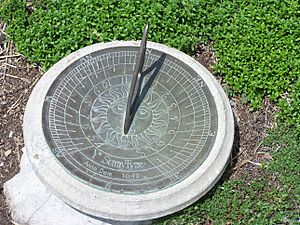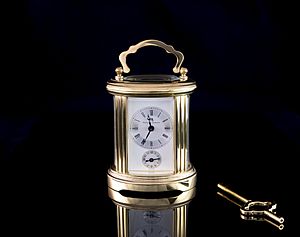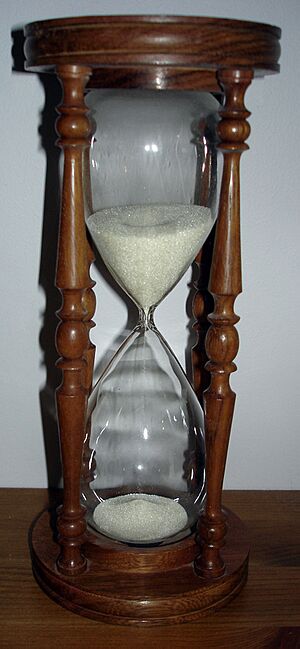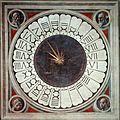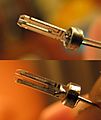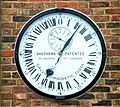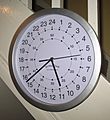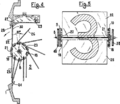Clock facts for kids
A clock is a cool tool that helps us measure, keep, and show time. When we say "clock" today, we usually mean any device that tells us the time. Things like watches, which you can carry with you, are a bit different from bigger clocks.
Clocks are some of the oldest things humans ever invented! People needed a way to measure time in smaller chunks than a whole day, a lunar month, or a year. Over thousands of years, people have used many different ways to make clocks. For example, a sundial shows the time by looking at where a shadow falls on a flat surface. There are also timers that measure how long something takes, like an hourglass. Water clocks and sundials are probably the very first tools used to measure time.
Contents
How Do We Measure Time?
Sundials: Nature's Clocks
The Sun seems to move across the sky during the day because our Earth is spinning. This means that shadows from still objects also move. So, people figured out they could use these shadows to tell the time! A sundial shows the time by displaying a shadow on a flat surface. This surface has marks for each hour. Sundials were very popular in ancient times.
Timers for How Long Things Take
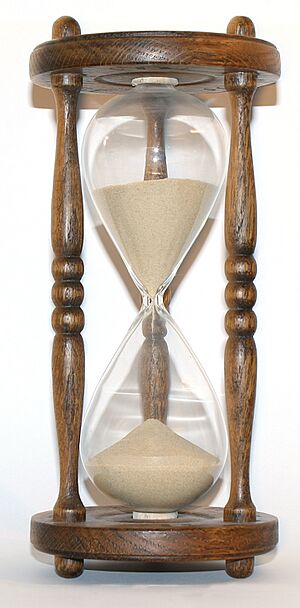
Many devices can help us measure how much time has passed, without telling us the exact time of day. These are great for timing how long something takes. Good examples of these timers are candle clocks and the hourglass.
How Clocks Keep Time
Clocks use different methods to measure time. They all need something that moves or "beats" steadily to keep track of time passing. Old water clocks worked by water slowly dripping from one container into another through a small hole. Other clocks use swinging pendulums, springs, and gears to keep time accurately.
Modern digital clocks measure time by counting the tiny vibrations of quartz crystals. These crystals vibrate at a super steady rate when they get a little bit of electricity.
The most accurate clocks in the world are Atomic clocks. They use the waves given off by tiny particles called atoms (like caesium) to measure time. They are incredibly precise!
How Clocks Show Time
There are many kinds of clocks and watches. The two main ways clocks show the time are "analog" and "digital".
Analog Clocks: Hands and Faces
Analog clocks tell time using angles. They have "hands" that spin around the clock's "face." The position of these hands tells you the time. The clock face is usually a flat disk with numbers one through twelve to make it easy to read.
Most analog clocks have two or three hands.
- The longer, bigger hand is the minute hand.
- The shorter hand is the hour hand.
- If there's a third hand, it's usually thin and about as long as the minute hand. This is the second hand.
Each hand shows the time it's named for. It moves all the way around the clock face before the next bigger hand moves one step. For example, the second hand goes around the clock in 60 seconds. When it finishes a full circle, the minute hand moves forward one tiny mark. When the minute hand goes all the way around (which takes 60 minutes), the hour hand moves forward one number. The second and minute hands take 60 movements to go around, but the hour hand only needs 12 movements to do the same.
Digital Clocks: Just Numbers

Digital clocks show the time using numbers. You often see them with LCDs or LEDs. Unlike analog clocks that use a 12-hour system, digital clocks can use either a 12-hour clock (with "am" for morning and "pm" for afternoon/night) or a 24-hour clock. Digital clocks are often smaller and easier to read. Some new digital clocks can even set themselves using the internet or radio signals!
Clocks That Make Sounds
Some clocks tell time with sounds, often along with a dial. The sound can be as simple as a bell or as complex as a person speaking. Many older clocks that do this are powered by springs or weights instead of batteries. Special clocks that speak the time are helpful for people who are blind or can't see well.
Cool Types of Clocks
There are many different kinds of clocks and watches, each with its own use or style. Here are a few examples:
- A wristwatch is worn on your wrist. It has straps that go around your arm.
- A pocket watch is kept in a pocket. It often has a small chain connected to your clothing so you don't lose it.
- A Sundial is an ancient type of clock that uses the Sun's shadow to tell time.
- An alarm clock makes a sound (like a buzz or a bell) or plays music at a certain time. People use them to wake up from sleep.
- A grandfather clock is a very tall clock that stands on the floor. It uses a long pendulum to keep time.
- A Cuckoo clock is a clock that uses a pendulum. It makes a "cuckoo" sound every hour. Often, a small door opens, and a little toy bird pops out!
- An hourglass, also called a sandglass or sand timer, uses sand slowly falling from one glass bulb to another to measure a set amount of time.
Why Do We Use Clocks?

Clocks are everywhere! You'll find them in homes, offices, and many other places. Smaller ones, like watches, are carried on your wrist or in a pocket. Bigger clocks are in public places, like a railway station or a church. You'll also see a small clock on your computer screen, mobile phones, and many MP3 players.
The main reason we have clocks is to show the time. But some clocks can also make a loud sound at a specific time. These are called alarm clocks, and they're usually used to wake someone up. The alarm might start quietly and get louder, or you can turn it off for a few minutes and have it ring again. Some alarm clocks have special lights or pictures to help young children, who can't read the time yet, know when it's okay to get out of bed. These are sometimes called training clocks.
Images for kids
-
Clock face of the Elizabeth Tower in London, also known as Big Ben
-
A water clock for goldbeating goldleaf in Mandalay (Myanmar)
-
A scale model of Su Song's Astronomical Clock Tower, built in 11th-century Kaifeng, China. It was driven by a large waterwheel, chain drive, and escapement mechanism
-
Richard of Wallingford pointing to a clock, his gift to St Albans Abbey
-
The Dutch polymath and horologist Christiaan Huygens, the inventor of first precision timekeeping devices (pendulum clock and spiral-hairspring watch)
-
The Shepherd Gate Clock receives its timing signal from within the Royal Observatory, Greenwich.
See also
 In Spanish: Reloj para niños
In Spanish: Reloj para niños


